The Auris Audio Euterpe is the company’s latest desktop tube amp featuring a headphone, DAC/Preamp capability and a unique enclosure that duals as a headphone stand. It retails for €1,499.00.
Disclaimer: The Auris Audio Euterpe was sent to us in exchange for our honest opinion in this review. Many thanks to Auris Audio for giving us this opportunity.
You can read more about previous Auris Audio products reviewed or referenced on Headfonics here.
For those that have read our original intro First Contact feature, you will find a degree of overlap on page 1. We recommend you skip to page 2 for our in-depth sound analysis, comparisons, and matchups. For those that are coming fresh to the Euterpe please do read on.
Auris Audio’s quality in tube amps is not unknown to us. Their fantastic desktop HA-2SE won the Best Tube Amp for 2018 with a near-flawless low noise floor and a very balanced presentation. The new Euterpe is quite different in form and function but at its heart is another tube amp creation.
The launch price of €1,499.00 is somewhat lower than the HA-2SE’s €2,070.00 but do not let the numbers fool you as there is plenty going on with the Euterpe and more than just a tube amp.
Tech Inside
The Euterpe actually encompasses 4 key functions into one reasonably compact but incredibly elegant component design.
Multi-functional
It can act as an all-in-one desktop amplifier and DAC, a pure DAC (with modern source OTG input capability), a pre-amp, and a pure tube headphone amplifier. The one additional function, that I did not include in the original 4 as its more outside than inside, is the ability for it to also act as a headphone stand.
DAC
The DAC inside has some baseline specs including a decoding capability of up to DSD128, PCM max 32bit/384kHz with an XMOS USB stage for digital audio input. We do know the DAC inside is a Sabre DAC so my presumption is that it is an ES9018 and the DSD128 limit comes from the XMOS implementation.
Amplifier
The Euterpe amplification stage is multi-functional with both pre-amp functionality and dedicated headphone amp duties. The dedicated headphone side will draw either from the internal amp or you can bypass with your own external DAC as your main source. You can also bypass the direct headphone output with a set of pre-outs in case you want to connect the Euterpe to a more powerful amplifier.
This is a single-ended or unbalanced circuit design so no balanced inputs or outputs but they do have that nice impedance selector similar in function to the more expensive HA-2SE impedance selector capability.
This does make a difference though the application is slightly different from the HA-2SE. The Euterpe has two switches at both high and low whereas the HA-SE had ohm specific settings. The inference here is a wider range and simpler switching design at 32-80 Ohm and anything greater than 150 Ohm.
Linear PSU
The Euterpe power supply is a good one also. This is an external regulated linear power supply with a switchable 115 / 230 VAC capably output and will keep noise to a minimum. It uses a fairly stiff but sturdy 4-pin connector 1m cable so you can place the 2 units pretty far apart.
Design
Aesthetic
I find the Euterpe to be attractive, unusual and with function as well as form. This is a tall and quite beautiful design with a mix of aluminum and walnut wood housed on a steady rubber footed metal plinth. It really stands out for how unique it looks but I am sure Auris will want to give some credit to Valentin, the CEO of Kennerton Audio for the original inspiration behind some of the design with their Atlas amp.
The name Euterpe is also relevant here being one of the nine muses of Greek mythology and the Goddess of music. The actual shape is intended to be in the form of a harp or lyre though Euterpe historically is more associated with a double flute. I believe it is Erato, another muse who is known to have a lyre in her hand in many classical depictions.
A Headphone Stand
I am digressing though. Suffice to say the wood finish surrounding the much smaller aluminum amp enclosure is distinctive. Yet on top of the Euterpe, you will find another useful function provided from a small curve in the middle of the wood enclosure.
This curve is designed to also act as a headphone stand and yes, it will take a full-size headphone and no, it won’t heat up and burn your precious cans. I left the Empyrean on it for 4-5 hours the first night and apart from some mild warmth on the strap, there were no side effects.
The tubes are aligned centrally at the top of the matte black aluminum housing with good separation between the top and sides of the wooden enclosure. They seem well protected from bumps, knocks and accidental finger touching.
Footprint
What surprised me, despite the overly large packaging, was just how little space the Euterpe took up on the rack. The overall dimensions of the Euterpe are 270mm tall x 210mm wide x 230mm deep and beside the HA-2SE is much smaller looking.
Yes, it is tall, much taller than the HA-2SE but narrow and not terribly deep or wide save for an additional inch or two for the metal plinth base. That height will likely mean it needs plenty of open space and unlikely to sit well in a middle tier of any regular audio rack unless its 30cm or taller.
Also, considering it doubles as a headphone stand you will need 5-10cm more space to accommodate the additional height from a headphone headband.
The other thing to watch out for is the weight and additional large PSU block. The Euterpe is 4.1kg in weight which might surprise you considering its fairly compact size and the linear PSU is 1.1KG alone. You also need to find somewhere to slip that block reasonably far away from the main unit as PSU cable is reasonably long and quite stiff making it not so easy to bend.
Functionality
The Euterpe impedance, source volume controls are to the front along with a single-ended 6.35mm jack output. To the rear, pre-amp, USB digital audio input, and analog Dual RCA inputs. The PSU is also connected to the rear with a 4-pin socket towards the base of the amp. There is no balanced amplification inside the Euterpe design.
The volume pot also doubles up as a power-on resistance-based switch and you will have to wait a few seconds after turning it on for it to activate. A small safety precaution if you will. There is no stepped attenuation design to the pot here, this is a custom Alps potentiometer design with a very smooth turn. Also, thank you so very much Auris for putting in some white markers to judge volume levels accurately.
The level of potential functionality of the Euterpe seems excellent though our primary review focus will be on the built-in DAC and amp all-in-one performance. That being said, the pre-amp and analog inputs as a pure amp combined with a higher-end DAC such as the Qutest and even an M-Scaler behind that will be intriguing to see just how good the SET amp inside really is.
DAC
If there is one area that I am cautious on with the Euterpe it is the ES9018 DAC chipset. Now, this is not a bad chipset but it is a fairly old one with various noise and THD+N figures that would normally be higher than modern-day configurations.
With the ES9028/38 chipsets, even the Q2M mobile versions the tuning for me is very refined and remedies some of the challenges companies had in working with the ES9018. I tended to find the ‘Sabre Glare’ or treble hardness quite pervasive in ES9018 solutions from years ago quite distracting. It is part of the reason why AKM chips grew in popularity simply because engineers found them fairly easy to fine-tune.
That being said, and something I will go into more detail on page 2, the ES9018 implementation here does not exhibit any unwanted glare simply because the tube amplification section is so good. Auris have done an excellent job with the implementation and amp stage to rid the Euterpe of any unwanted glare and hardness though it is a fairly neutral sound by tube standards.
Decoding
Decoding is expansive but not top-tier. You will be able to go up to DSD128, PCM max 32bit/384kHz with an XMOS USB stage for digital audio input. The ES9018 is not the hard stop here for DSD128 but rather the USB XMOS. In truth for 90% of my collection that will be more than enough decoding capability but I do have plenty of DSD256 also that I would love to try.
The one additional benefit of the Euterpe is that you are not forced to use the internal DAC. You can feed an external DAC into the amping stage and believe me this is where the Euterpe can really shine.
Amplifier
The lineup of tubes for the amp stage in the Euterpe is classic Auris with the use of 2 7-pin Ei PL95s, which are the equivalent to 6DL5’s and a single ECC81 input tube, otherwise known as a 12AT7 running in Ultra-Linear mode. The ECC81 supplied stock tube is a JJ Electronics branded version.
The output power is quite similar to the HA-2SE or just a shade lower at 0.9W into a 32Ω load. That places at a moderate power level and should have no issues with all but the most demanding of headphones.
That means something like Hifiman’s HE6 or HE6SE might struggle in terms of dynamic range but modern planars like the Empyrean will have no issues. Dynamic driver headphones should have more than adequate power also. The rest will be more about synergy and you can read more about that on page 2 of this review.
To assist you with ensuring you get the most out of various headphones Auris has also implemented a similar impedance matching system as the HA-2SE. It is not quite as expansive with just two settings instead of four but the two settings are fairly comprehensive at 32-80 Ohm / High > 150 Ohm. Believe me, this selector does have an influence on how dynamic a headphone can sound with the Euterpe.
Packaging & Accessories
The box is huge, too big for some nice pics, but an attractive huge by most courier standards. This is a massive white cardboard box with plenty of foam lining separating the amp from the linear power supply. The tubes are already preinstalled so there is no additional cubby hole to protect them. The amp’s design already does a good job of keeping them safe from knocks.
You will not find too much in the way of accessories outside of the linear power supply. However, there is a small manual on how to piece everything together for the various inputs and outputs. You do not get an additional USB cable or a power chord for the PSU, you will have to supply those yourself.
It should not cost too much though. I bought a fairly decent kettle type 3-prong power cable for $3 at the local hardware store today for that very purpose.
Sound Impressions
Summary
The Euterpe’s sound is heavily influenced by DACs, both in terms of dynamic range and timbre. You could almost call it a tale of two amps because with the internal stock DAC I feel the presentation is good but with a higher-performing external DAC the quality of that amp stage really shines.
The amp stage itself is reasonably sweet to neutral both in terms of timbre and quantity. Coming from the very balanced sounding HA-2SE, I honestly was not surprised to hear another Ei PL95s infused tube amp design deliver another balanced sound. However, the Es9018 internal DAC implementation takes it even further into neutral territory.
The Euterpe is relatively sweet in its general tone but not quite as rich in its timbre as the HA-2SE. It also sounds airier and grander in its presentation than the punchier more intimate Liquid Platinum from Monoprice.
Much of that has to do with the ES9018 DAC implementation which has a traditionally clean to somewhat bright overtone on resistor amps. You will not find anything bright with the Euterpe, there is no ‘Sabre glare’ to speak off. In fact, the stock presentation has a certain wetness to the very top-end that I find appealing.
This is no AKM AK4490EQ type sound which is punchier but more brittle in the top-end. It is relatively linear, nicely controlled, and with excellent instrumental separation.
External DAC’s
However, you can do better with an external DAC and if you have one you should try it because the Euterpe amp stage is very good indeed and does show a nice level of transparency. It also shows some of the limitations of the internal DAC.
I am not sure if the voltage output of the internal DAC design of the Euterpe is a little lower than it should be but pairing to our Chord Qutest or Cayin iDAC-6 MKII definitely increases the dynamic range and the perceived levels of volume are higher.
Switching to the analog input stage with the Chord Qutest/M Scaler behind there is a palatable jump in dynamic range and clarity from this high-end DAC setup. The ES9018 seems to do a solid job with instrumental separation, air and delivers some excellent detail but it sounds quite flat and less resolving in comparison.
You do get a bit more treble presence with the Qutest as a source but I tended to prefer that over the Yulong DA10 DAC pairing which faded and softened the mids and treble of the Euterpe a bit too much for me.
The Euterpe amp stage can really scale with a high-end DAC setup if you have it. The fact you are not limited to the internal DAC should prove a fairly useful feature. However, those without might find the additional costs of a decent DAC too much to bear, nevermind the huge outlay for a Chord Hugo M Scaler that adds some serious ‘pop’ to the Euterpe sound.
Noise
Whilst not as dead quiet as the impressive HA-2SE it is impressively low for a SET amp. It is only when you throw on some sensitive IEMs (Campfire Audio Polaris 2), do you pick up on any hiss and even then, it is acceptably low with a slight left channel imbalance at really low volume levels.
Otherwise, with planar headphones of medium efficiency such as the Meze Empyrean, you will not hear a drop of hiss, crackle or traditional tube pop. This is something I have come to expect with Auris amps from and the Euterpe really lives up to the expectation here.
Impedance Selector
This is more of a caveat than any tonal discussion. If you feel your dynamic range is a bit lacking for the volume setting on the Euterpe then check that impedance selector switch is set correctly. With the majority of planar headphones, they tend to rate less than 80Ω and are more impedance agnostic than dynamic headphones. You need to have that switch set to low or L.
If you have it high the energy will be sucked out of the likes of the Empyrean, Ananda and the Rad-0. Once it is down you get a substantial lift in the quality of delivery with a solid more planted sound.
Testing with the Sennheiser HD660S which is a 150Ω dynamic driver headphone and the impedance selector made a massive difference. With it down, the presentation was limp, seriously lame. Once we went to high the range was superb, the timbre richer and we got a far more resolving sound quality.
Matchability
Efficiency & Power
The Euterpe is rated at 0.9W into a 32Ω load which is middling in terms of absolute power. It is not as gutsy as the Monoprice Monolith Liquid Platinum at 1,8W into the same load or even the Yulong DA10 which puts in an impressive 2W into 32Ω unbalanced.
It does not have balanced either so it cannot really go to the most inefficient of headphones and get optimal performance. Modern planars around 100dB are fair game for the Euterpe whereas anything that was nipping at 90Ω or lower would benefit from 1-2W more power at that load level.
I had no issues at all driving the Meze Empyrean and the Final D8000. Also, the Rosson Design RAD-o sounded excellent. All of these headphones run close to the 100dB SPL marker or above and I tend to view them as fairly easy to drive. None of them went above 12 noon on the alps pot with the Empyrean impressing the most with the internal DAC and the RAD-0 offering a more dynamic synergy with the Qutest feeding the Euterpe in pure amp mode.
Synergy
Probably my two favorite pairings were the Empyrean and the Sennheiser HD660S, one planar and one dynamic. The Empyrean was just fine with the internal DAC, as was the HD660S but paired with the external Qutest/M Scaler digital feed the Euterpe amp stage was just outstanding with these two headphones.
The Empyrean sounded very resolving, as it should, without a hint of treble laziness that some relaxed amps such as the Yulong DA10 can sometimes feed into the Empyrean. Often, I hear the Empyrean being tagged as “boring” but with this setup, it is anything but boring, especially with the leather pads combo which I find to be more energetic than the velour alternative.
You do get a hint of that flatter sound though when you kick in the internal DAC as your digital source, it simply doesn’t cut the mustard with either of these headphones. The HD660S in particular sounds slightly veiled when you switch back to the internal DAC.
What should you avoid? Honestly, anything that needs a ton of power or achingly neutral in its presentation, The Abyss Diana Phi sounded a bit too lean and unforgiving with this setup and I tend to prefer that with a lot of power and a warmer DAC. The Hifiman Susvara and HE6SE also fall into the same category as the Phi. They simply need more power to sound optimal though I had no issue really with SPL.
Select Comparisons
Auris Audio HA-2SE
€2,070
Technical
The HA-2SE is sort of the bigger sibling of the Euterpe but it is a tube headphone amplifier only with no internal DAC. It also does not have any pre-amp duties so a pure headphone amp only whereas the Euterpe’s DAC/Amp combo does have a lot more usage scenarios.
The HA-2SE, like the Euterpe, is a single-ended amp in design with no balanced output or inputs. It does have more RCA inputs than the Euterpe with up to 3 sources allowed and a front-end mechanical selector. The impedance selector is also a bit more complex with 4 choices starting at 50Ω going up to 600Ω. The Euterpe only has two covering 32-80 Ohm and > 150 Ohm so just a little less refined.
Build-wise the HA-2SE is just as unique but its finishing for me is a little more opulent, more high-end with that vintage leather wrap and high grain woody finish. The wood finish is just as good on the Euterpe, but the amp enclosure is a plainer dark aluminum build.
The HA-2SE is much bigger and heavier at 9Kg and its spike stands with isolator caps require careful placement on glass tops. It also has a handy remote control which is something I would love for the Euterpe.
Performance
Both tube amp stages share some commonality, especially on the tube side. The Auris HA-2SE uses a 4+1 tube configuration of either 7-pin EL95 or PL95 tubes which are the equivalent to 6DL5’s. The single input tube is a Tung-Sol 12AU7W / 6189.
The Euterpe also uses two 7-pin Ei PL95s and a single ECC81 input tube, otherwise known as a 12AT7 running in Ultra-Linear mode. The ECC81 supplied stock tube is a JJ Electronics branded version. Both have switchable aspects between the PL and EL tube setups.
The two amps have relatively comparable output numbers as a result with the HA-2SE running around 1W into a 32Ω and the Euterpe just a shade lower officially at 0.9W into the same load. Both would be classified as medium efficient amps and should be able to drive similar type headphones.
We tested both the Hifiman Susvara and Meze’s Empyrean and neither really had any issues at all with current or volume. You can get them sufficiently loud with both amps with plenty of headroom to spare for the Empyrean in particular. However, the HA-2SE had a very minor edge in terms of dynamic range because of the superior external Qutest DAC we were using. The Empyrean also drives very well from the Euterpe but the Susvara, as it the case with the HA-2SE, really needs a bit more power to sound optimal.
Tuning
We decided to work a Chord Qutest into both amps and bypass the internal DAC of the Euterpe to get a better idea of what both amp stages could do. For me, the Euterpe is a little on the cleaner side as an amplifier and the HA-2SE has a bit more classic SET texture and richness to its timbre.
You can hear a little bit more hardness in the treble on tracks with percussion is lively, usually rock tracks. On the HA-2Se, that percussion timbre just softens a little, becomes a shade more liquid with slightly better texture. The Low-end on the HA-2SE also has a little more punch and body whereas the Euterpe sounds the more linear and controlled of the two.
You can hear that also in the vocal delivery with the HA-2SE adopting more of a sweet and no-fatiguing analog overtone and the Euterpe just a little more ‘solid-state’ in its voicing. What I mean by that is a shade less ‘fleshed’ out, a bit faster sounding and some more crispness to the delivery.
The HA2-SE is not as peppy sounding up top as the Euterpe treble presentation so if you do need some treble presence on headphones such as the Empyrean the Euterpe is a good match. However, for something like the more neutral and unforgiving Diana Phi, the HA-2SE’s slightly more even-harmonic balance and sweeter tone is the superior match.
Monoprice Monolith Liquid Platinum
$799
Technical
The Platinum is a hybrid balanced and single-ended tube amp based on the excellent Alex Cavalli Liquid Carbon a few years earlier. Monoprice has basically taken on the IP in coordination with Alex to come up with a balanced version at a fraction of the price.
There are no DAC or pre-amp functions inside the Platinum so its usage scenario is more limited than the Euterpe to just headphone duties. However, you do have a phase splitter design that allows you to connect multiple sources in balanced and unbalanced to the Platinum.
You get 4 different types of amp variation with that phase splitter design that allows you to use them all in balanced mode if you prefer. You can go SE to balanced, SE to SE, balanced to SE and balanced to balance. The Euterpe does not have that flexibility but compensates but offering a wider source range and of course, can pre-amp and use its own internal DAC.
The Platinum is also quite a bit smaller than the Euterpe with a bland design I am not bowled over with. The Euterpe is much more attractive and unique to me than the industrial design of the Platinum.
Performance
The comparative focus here is really how both amp stages perform with a similar DAC attached, in this case, the Chord Qutest. The output numbers are quite different with the Platinum the more powerful of the two amp stages. The Euterpe should be considered a medium rated amp stage at 0.9W into 32Ω. the additional impedance matching switch does help fine-tune that load balance which is something missing on the Platinum.
The Platinum raw numbers are much higher on a 32Ω at 6.62 watts balanced and about double unbalanced at 1.78 watts. This is the more powerful pure amp stage of the two and the one you will pick for challenging planars such as the Hifiman HE6 and the Abyss Diana Phi. However, most modern planars are efficient enough to drive just fine at 1W into a 32Ω load on the Euterpe such as the Empyrean and Hifiman’s Ananda.
Of course, you can attach the Euterpe to the Platinum in pre-amp mode to produce a killer system with all that additional power the Platinum offers.
Tuning
The gain on the Platinum is more aggressive and with the additional power, you do have to be a shade more careful with easier to drive headphones when pushing up the dial. The Euterpe is a little smoother but still gets loud quickly.
Tonally, the Platinum is thick, rich and treacle-like smooth from top to bottom. The Euterpe is cleaner, airier and more precise but lacks the girth and punch of the Platinum bass to lower-mids. The Platinum is not like the DA10 (see below) in its low-end delivery which I find a bit soft and overly bloomy in nature. There is a better balance in the sound of the Platinum with a more treble presence than the DA10.
The Euterpe timbre is relatively sweet-sounding but not quite as rich and intimate sounding as the Platinum. It pulls back a bit with that more neutral delivery hence the perception for me that it is slightly more grandeur in its presentation. The Euterpe also doesn’t seem to have the same level of decay in the notes so you could argue the presentation is slightly tighter with more separation on the Euterpe.
Yuling DA10
$1200
Technical
The Yulong DA10 is a solid-state integrated DAC and headphone amplifier. The DA10 is both balanced and unbalanced compared to the Euterpe’s single-ended only design. Like the Euterpe, it also can operate as a pure headphone amp, pure DAC and a pre-amp and can receive a wide variety of external sources.
Outputs are a bit more wide-ranging on the DA10. You have single-ended and balanced RCA and XLR to the rear for analog pre-amp and DAC to amp connectivity compared to the two. You also additional optical and coaxial digital inputs. The Euterpe has a wider range of single-ended with two RCA sockets for both input (bypassing the DAC) and pre-amp output but no balanced. Digital inputs are via a single USB socket so no SPDIF capability.
DAC capabilities are a step up on the DA10 compared to the Euterpe. The DA10 uses a more modern single-channel AKM4497 with a higher-end XMOS XU208 input stage allowing native decoding up to DSD 512 and PCM768kHz. The Euterpe uses the older ES9018 single-channel, also with XMOS USB but limited to DSD128 and PCM384kHz. It is no final indicator of sound quality but on a like for like, the DA10 is more capable as a pure DAC.
Build
Build-wise the DA10 is very much your classic black box design compared to the more boutique and eye-catching Euterpe. It is flatter, deeper but nowhere near as tall as the Euterpe and built from aluminum from top to bottom with a black lick of paint.
The standout is the LCD panel which makes switching modes so much easier to understand. Not that it is hard on the Euterpe but rather changing modes is more old school with diodes and switch indicators. Both weigh roughly the same though at 4Kg and 4.1KG. The DA10, however, does not use a linear power supply. Instead, it is more of a classic switching supply which some may shy away from.
Performance
On the amplification side, we do not have any hardcore performance numbers from Auris regarding noise but going on the high-level output numbers the Class A amp of the DA10 in balanced is more powerful at 3W into 32Ω and 2W unbalanced compared to the 0.9W of the Euterpe unbalanced on the same load.
The DA10 is not as nuanced though as the Euterpe for impedance matching and once you go up to around 300Ω onwards the DA10 is not such a hot deal at t 230mW and at 600Ω it is rated at 110mW. I have no load numbers from the Euterpe to match so we can only go on subjective hearing if that is also the case with high impedance dynamic headphones.
Tuning
The DA10 has a lot more bass bloom and weight as well as a slightly softer warmer timbre than the Euterpe. The Euterpe sounds more controlled, more linear and with better vocal presence and top-end clarity.
The DA10 has more of a linear fade from the low-end to the treble so things start to lose a little more focus the further up the frequency response you go with the likes of the Empyrean and Senn’s HD660s. So, if you are listening to heavy EDM or modern R’n’B then the DA10 sounds the more impressive of the two because of that better low-end weight and body shining through.
However, switch to singers such as Ann Brun or Anggun and the Euterpe has a better vocal tone, presence, and slightly more accurate timbre. The DA10 sounds smooth but a little more distant from around 1k onwards so vocals have less pop and the treble more relaxed in its delivery. The effect makes you feel the DA10 lacks a “pop” and just overly smooth.
In short, if you are after an “all-in-one” with a bit more bloom and bass to lower-mids presence then grab the DA10 but if you want balanced, neutrality and better vocal presence then the Euterpe is more appropriate.
Our Verdict
I love the amplifier inside the Euterpe. It is a relatively neutral to slightly sweet tone, very low on noise and can scale with a great source. The power is middling, not as strong as some solid-state contenders but for modern planars and dynamic headphones, it does perfectly fine. As a tube headphone amp, it has a subtle contrast to its bigger slightly richer sibling, the HA-2SE.
The weak spot is the internal DAC. Now tonally, its a really nice implementation of the Sabre sound with none of the harshness I tend to dread on solid-state ES9018 alternatives from years ago. Auris have done a really nice job tweaking a very balanced and neutral quality from the DAC.
However, it lacks a little dynamic range for me and compared with external DACs such as the Chord Qutest it is not as vivid sounding. I still much prefer it to the Yulong DA10 mids to treble fade but I just wanted a bit more from the internal DAC.
The magic of the Euterpe is really when it is connected to a high-end DAC which tells you a lot about how good that amp can be inside that beautifully crafted woody enclosure.
Euterpe Specifications
- Tubes 2 x PL95, 1 x ECC81
- Amplifier Configuration Single Ended
- Power output 0,9 W
- Conversion rate USB: DSD64, DSD128, PCM max 32bit/384kHz
- Output Impedance Low 32-80 Ohm / High > 150 Ohm
- Power supply 115 / 230 VAC
- Inputs 1 x USB, 1 x RCA
- Outputs 6.3 mm Stereo / RCA Pre out
- USB Driver Windows
- Dimensions (WxHxL) mm 270 x 210 x 230
- Weight (kg) 4.1/NET (without PSU)
- Weight (kg) PSU 1.1/NET
- Dimensions PSU (WxHxL) 95mm x 185mm x 55mm
*This review is taken from the Headfonics web page, from the following link:
https://headfonics.com/auris-audio-euterpe-review/



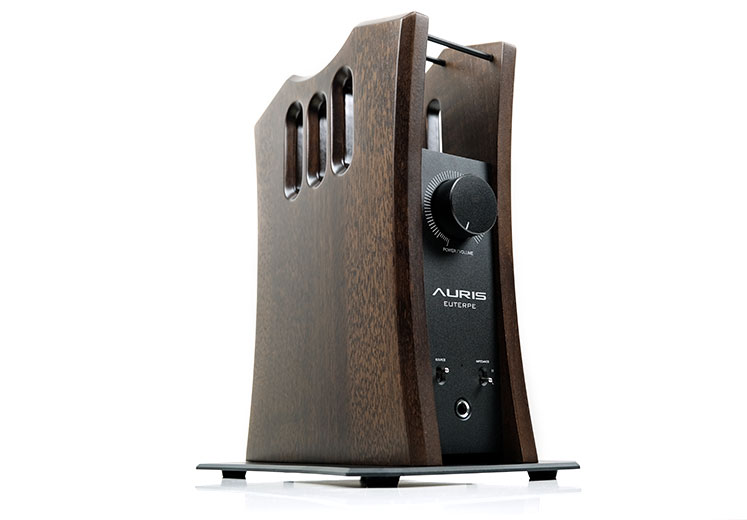
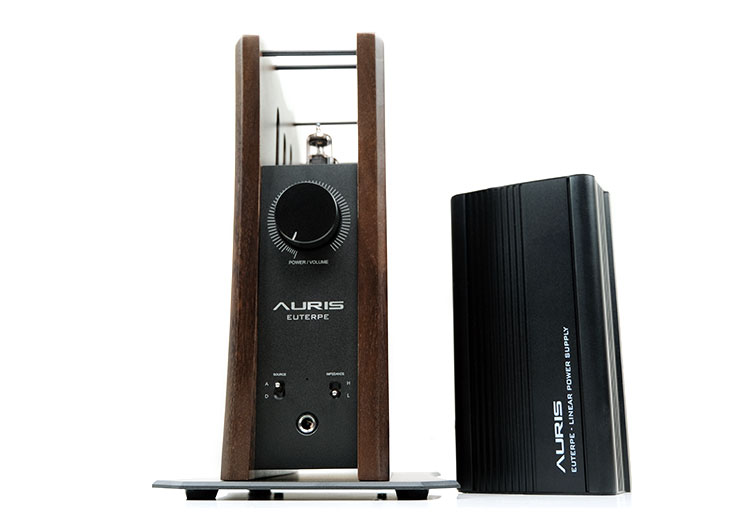
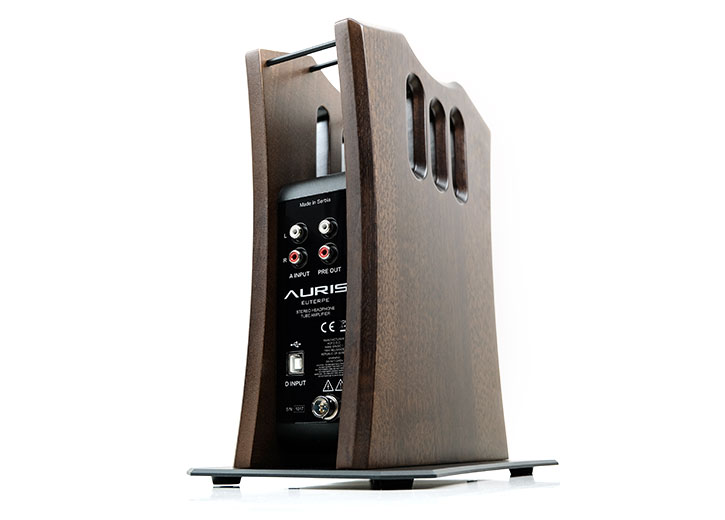
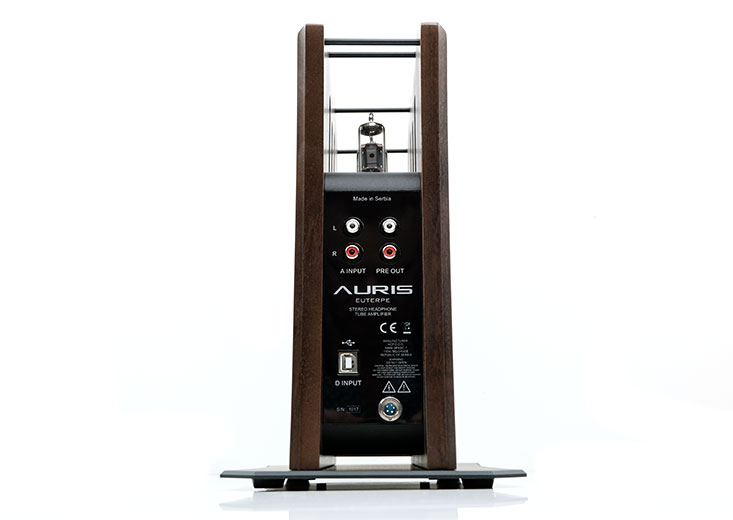

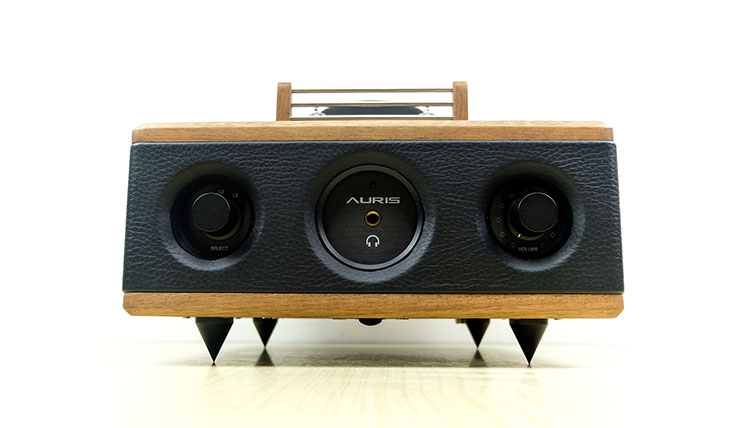
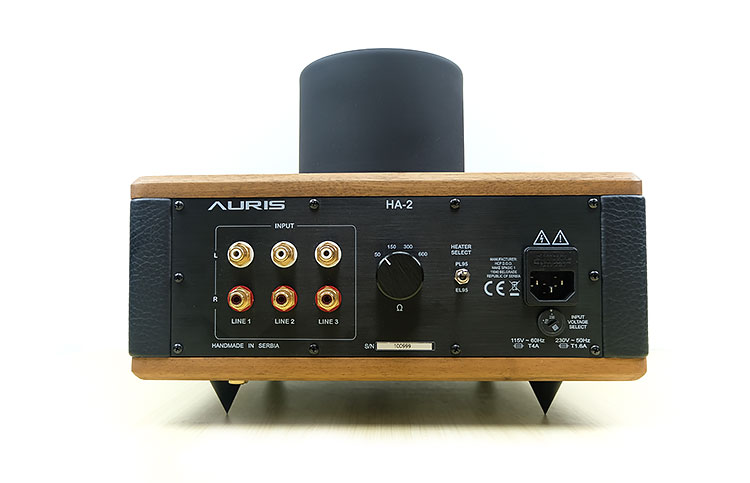
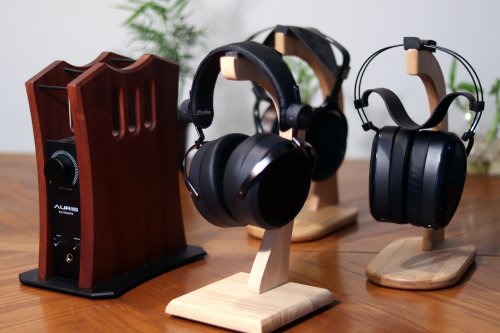
Leave a comment
This site is protected by hCaptcha and the hCaptcha Privacy Policy and Terms of Service apply.